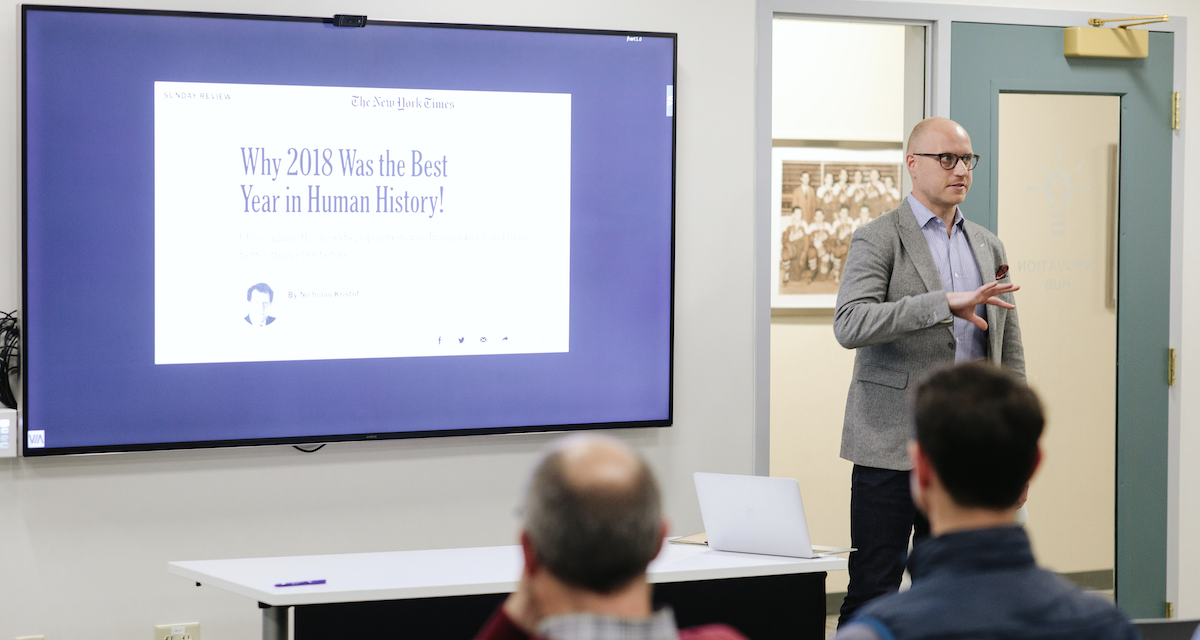Creating as a Calling: Student Reflects on Visit from Praxis Lab’s Jon Hart
Have you ever thought of blessing recruiters through your LinkedIn profile? I had not.
As a senior, with the pressure of graduation just a few months away, I’ve been more concerned with choosing the right headshot than improving someone else’s day with my clear work descriptions. But after an hour and a half with Jon Hart of Praxis Labs, my LinkedIn profile was back in draft.
Hart kicked off the Career and Connection Institute’s Calling and Career Series, a new spin on a traditional Gordon conference, with an interactive keynote address, in which he proposed a redemptive framework for approaching work and life.
The foundation of his framework stems from Genesis, where a Christian’s conception of work begins. Hart pointed out that after doing all the hard work of forming complex animals and carefully balanced ecosystems, God invites Adam to do the last and essentially easiest task of any creative process: naming. But naming is a creative action.
“There’s an invitation to a creative activity, and there is creative freedom to go about that,” said Hart.
In a similar way, each of us has been gifted with talents, interests and a brain that we have the pleasure of creating with. That’s the invitation to create.
Hart’s redemptive framework didn’t stop at Creation. It pulled from ideas that are central to the gospel story. In our world, there’s a tension that exists between brokenness and beauty. Jesus kickstarted the redemptive process, but it’s not yet complete.
“Our invitation is to join God in the renewal of all things. When we work, we work in this middle place of tension,” said Hart. “If we join God in this renewal project and see our work as important to the world, we can ever so slightly bend it toward redemption, restoration, beauty in the world, or we’re going to aim it at brokenness.”
Hart proposed that we participate in what he calls redemptive action: following the pattern of creative restoration through sacrifice in our life and work.
The term “redemptive work” immediately brought to my mind visions of nonprofit workers fighting human trafficking on the North Shore of Boston or addressing homelessness in Philadelphia. And while many passionate, 20-somethings are rearing to do that work, the reality of our future is that it is accompanied by student loans. So, yes, redemptive action is great. But can it be practical?
Hart worked at Best Buy right out college to pay off student debt. It wasn’t particularly purposeful work. However, on the side, he ended up partnering with a group of friends and a photographer to start 100cameras, a nonprofit organization that shares the gift of photography with children all around the world.
For Hart, redemptive action could look like a certain posture at work, but it could also mean using his passions and skillset outside of his day job to further a nonprofit he believed in. Redemptive action is not just being respectful to those around you or being willing to chat with your colleague in the elevator. It’s about being aware that if you try to beat competitors by negotiating an extremely low price for a product in a business deal, somebody will have to pay the price. In that situation, it’s normally factory workers on the other side of the world who may have to work overtime with no pay because of your decision.
Like the diversity of career options, the ways that one can participate in redemptive action abound.
Redemptive action could look like working for a company that has an ethical supply chain or it could mean making your LinkedIn profile clear and straightforward so that a recruiter is able to easily understand your skillset. You’re not just being truthful or honest—you’re going one step further.
“The reality is most of us are going to go work as a teacher in a school system, as an employee at a large corporation,” said Hart. “But what I find is that most people who are in those roles, all they ever do is complain about their inability to change anything. Remember what ‘redemptive’ is? It’s generative. It’s creative. It’s following that creative restoration through sacrifice.”
Redemptive action is not just about being a better person, it’s about creating a better world.
By Veronica Andreades ’20, English language and literature
 The Bell
The Bell